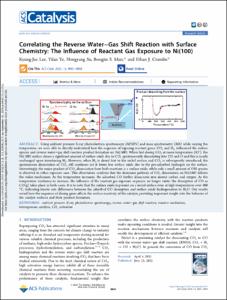GIST Scholar
College of Natural Sciences
Department of Physics and Photon Science
1. Journal Articles
Correlating the Reverse Water-Gas Shift Reaction with Surface Chemistry: The Influence of Reactant Gas Exposure to Ni(100)
- Type
- Article
- Citation
- ACS Catalysis, v.13, no.13, pp.9041 - 9050
- Issued Date
- 2023-06
- Abstract
- Using ambient pressure X-ray photoelectron spectroscopy (APXPS) and mass spectrometry (MS) while varying the temperature, we were able to directly understand how the sequence of exposing reactant gases, CO2 and H2, influenced the surface species and reverse water-gas shift reaction product formation on Ni(100). When first dosing CO2 at room temperature (RT), the Ni(100) surface shows a significant amount of surface oxide due to CO2 spontaneously dissociating into CO and O and this is nearly unchanged upon introducing H2. However, when H2 is dosed first to the nickel surface and CO2 is subsequently introduced, the spontaneous dissociation of CO2 still continues yet it forms less surface oxide due to the pre-adsorbed hydrogen on the surface. Interestingly, the major product of CO2 dissociation from both reactions is a surface oxide, while only a small amount of OH species is observed in either exposure case. This observation confirms that the dominant pathway of CO2 dissociation on Ni(100) follows the redox mechanism. As the temperature increases, the adsorbed CO further dissociates into atomic carbon and oxygen. As the temperature continues to increase, the influence of the reactant gas exposure sequence no longer exists: the desorption of CO as CO(g) takes place in both cases. It is to note that the surface oxide is present on a nickel surface even at high temperatures over 400 °C, indicating kinetic rate differences between the adsorbed CO desorption and surface oxide hydrogenation to H2O. Our results reveal how the sequence of dosing gases affects the surface reactivity of the catalyst, providing important insight into the behavior of the catalyst surfaces and their product formation. © 2023 The Authors. Published by American Chemical Society
- Publisher
- American Chemical Society
- ISSN
- 2155-5435
- Appears in Collections:
- Department of Physics and Photon Science > 1. Journal Articles
Items in Repository are protected by copyright, with all rights reserved, unless otherwise indicated.
